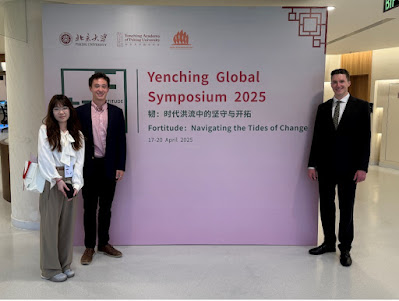Community building through global rituals - attending Easter mass in Taiwan
MAIS student Nathan Rose relocated to Taipei, Taiwan for the second semester of his first year. As he navigates the complex task of building a community of friends abroad, Nathan reflects on his attendance at Easter mass in a Taiwanese church, and the shared community of faith that he encountered.
Last month was Holy Week. For those not familiar with Catholic traditions, Holy Week refers to a string of religious holidays starting with Palm Sunday and ending with Easter, as well as encompassing Good Friday. It is, canonically, one of the most important religious holiday(s) in the Catholic tradition, as this week is when Jesus’s death and resurrection is remembered and celebrated. It also represents the end of Lenten fasting. Lent is the traditional Catholic fasting period, in which practitioners are asked to either give something up or do something extra for a period of 40 days. In this way, Holy Week represents (canonically) the completion of one journey (the Lenten 40 day fast) and the beginning of another: which begins on Ash Wednesday. Ironically, Ash Wednesday was the day I left the U.S. I spent all of quarantine in Lent, and Easter occurred a little after I had fully left quarantine and had moved into my long-term housing. Thus, there seemed to be some odd coincidental parallelism, which perhaps helped contribute to the personal significance of this story.
It is also worth noting that Taiwan has a much stronger and more vibrant religious scene than I first expected. There are, of course, plenty of Buddhist, Confucian, and Daoist temples here (although the sheer number of them does somewhat boggle my mind). What I found surprising was the number of Christian churches here. Right after getting out of COVID restrictions, I went exploring. I poked my head into what turned out to be a religious bookstore near my place. Various churches near campus and Da’an park make lit-up crosses a surprising addition to the Taipei skyline. A quick Google search reveals various churches, temples, and mosques nearby. Fortunately for me, I found two different Catholic churches near my neighborhood.
I attended Good Friday mass at the Guting Church relatively close to campus. The Guting Church is an interesting building; it is not a cathedral, but it is nonetheless tall (at least relative to my American standards). The first floor holds the main chapel or church area. If one were to enter just this section, one would think the Guting Church was just like any other church—it has the normal wooden pews, altar, high ceilings, etc. Yet above the church is not the roof, but more rooms—the church offices, classrooms, etc. In other words, all the services one would expect to find on a parish campus were here—they were just organized vertically.
I went with an American friend who was studying Chinese at NTU. We went to the English-language services (sorry mom, but my Biblical Chinese isn’t exactly strong and I’m not exactly a regular mass-goer). Because it was Good Friday, both English and Taiwanese services were in session. However, due to limited space (and differing crowd sizes), the English mass was sent to a smaller classroom upstairs. Consistent with local norms around footwear, we were asked to take off our street shoes before entering. We were provided plastic bags to put our shoes in and were provided house shoes to enter. We filed into the classroom. The room was packed with people from all over the world; I could only guess where everyone was coming from (although, unsurprisingly, I would wager that many were Taiwanese). Judging from his accent, our deacon seemed to come from England. Guessing from his name, our priest came from somewhere in West Africa. Here we all were, a mix of nationalities squeezed into a small classroom, united in purpose and ritual both in the parish and with the larger, global community of Catholics.
Parochial is an adjective that has two meanings: one refers to a church or a church parish, the other is as a synonym to small-mindedness or insular worldviews, and serves as an antonym to cosmopolitan. For most of my life, masses have been parochial experiences. Perhaps the most archetypical experience of this occurred when I visited my mother’s Aunt Erna in rural Idaho a couple years back. We came to visit over a long weekend and attended mass with her while we were there. While I cannot remember specifics, it was clear to me that this church was the beating heart of this community, and that I, due to my faith and connection to Erna, was a part of this community, even though I had never visited that town before. It was a most beautiful parochial experience.
I felt a similar sense of belonging here at Guting. Despite being new in town, I felt incorporated and welcomed into this community. However, while Idaho may have revealed the parochial nature of the Catholic Church, Guting emphasized its global nature. Here, cramped in this small classroom, was a motley assortment of international strangers. Together, we carved out a time to be foreign together. Yet, simultaneously, by participating in mass, we were communing not only with our fellow non-English speaking parishioners downstairs, but also with the broader community of Catholics worldwide.
One of my classes at HNC this semester is Perspectives on Globalization with David Arase, which seeks to analyze and assess the forces and effects of post-cold war globalization. However, since COVID and the war in Ukraine, it is clear that this trend of globalization has not only stopped, but is now in retreat. Professor Arase has re-written the syllabus three times this semester to capture this new and rapidly-changing reality. The news is never good—centrifugal forces continuously strengthen as the semester continues. It is easy to lose hope for any shared future. Yet, having participated in this shared global ritual, I cannot help but feel such pessimism may be premature. It is true that we are likely entering a more parochial era, but experience suggests that parochialism and cosmopolitanism may not actually be as mutually exclusive as dictionaries suggest.






